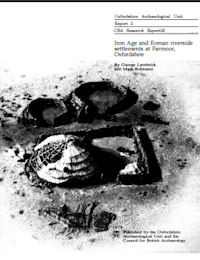CBA Research Reports
Council for British Archaeology, 2000. (updated 2020) https://doi.org/10.5284/1000332. How to cite using this DOI
Data copyright © Council for British Archaeology unless otherwise stated
This work is licensed under the ADS Terms of Use and Access.
Primary contact
Council for British Archaeology
92 Micklegate
York
YO1 6JX
UK
Tel: 01904 671417
Resource identifiers
- ADS Collection: 281
- DOI:https://doi.org/10.5284/1000332
- How to cite using this DOI
Iron Age and Roman riverside settlements at Farmoor, Oxfordshire
George Lambrick and Mark Robinson
CBA Research Report No 32 (1979)
Oxfordshire Archaeological Unit: Report 2
ISBN 0 900312 57 2
Abstract

Extensive excavations coupled with intensive biological analysis of all types have provided important new evidence for the changing settlement patterns and land use of Iron Age and Roman settlements on the first gravel terrace and floodplain of the Thames Valley.
The original settlement of the early Iron Age was represented only by a group of storage or rubbish pits on the relatively dry ground of the gravel terrace. Daub suggested the existence of a building and slag and other evidence indicated small-scale ironworking, but there was little indication of the overall character of the settlement. A subsequent gap in the occupation of the site was evident from marked changes both in the fabric and style of the pottery and in the settlement pattern itself, indicating ditferent land use and farming practice.
In the middle Iron Age three farmsteads comprising small ditched enclosures for circular houses and subsidiary yards or stock pens were constructed on the open floodplain, while other small enclosures, probably for stock, were made on the edge of the gravel terrace. One of these incorporated a fenced yard with an unusual semicircular post-built structure, perhaps a workshop. One of the floodplain enclosures had heen stripped of turf (possibly used to build a round house) and was later crossed by raised gravel paths. The floodplain farmsteads were situated in wet open grassland, subject to flooding from the river and used principally for pasture. The economy was entirely pastoral, and because of the flooding the settlement must have been seasonal, maximizing the value of the rich grassland in the spring and summer. The absence of some common perennial plants liking disturbed ground shows that each farmstead was used for no more than about five years. After the middle Iron Age the rate of alluvial deposition on the floodplain greatly increased.
The settlement pattern underwent a further change in the 2nd century AD. During the Roman period the floodplain remained unenclosed, but was abandoned as an area of habitation while the gravel terrace was enclosed for the first time with small fields or paddocks and a droveway crossing the terrace and turning along its edge. This laid-out field system and the probable existence of thorn hedges, indicated by botanical remains, suggests a much more permanent settlement than that of the Iron Age. Roman occupation of the site probably dates from the late 3rd century and by the late 4th century gardens with box hedges were established. The economy was still largely pastoral, and it is likely that some paddocks were used for intensive stock management, while the floodplain was almost certainly used for hay as well as for grazing. Corn was probably brought in, and evidence for the de-husking and milling of spelt wheat was recovered from a corndrier and various pits.
In the medieval period the area formerly enclosed by the Roman field system was converted to open arable land. The floodplain remained grassland as the meadow for the nearby village of Cumnor. The site was no longer occupied, but was probahly farmed from a hamlet or farm near the edge of the new reservoir.
Contents
- Title pages
- Contents (pp iii-v)
- PART I: Introduction (pp 1-7)
- Summary (pp 1)
- Acknowledgements (pp 1-2)
- Presentation of Results (pp 2-3)
- General Description (pp 3-6)
- Background to the Excavation (pp 6-7)
- PART II: Archaeological Evidence (pp 9-76)
- The excavation by George Lambrick (pp 9-34)
- Finds: the Iron Age pottery by George Lambrick (pp 35-46)
- Finds: the Roman pottery by Janet Sanders, with a section by Warwick Rodwell (pp 46-54)
- Finds: the coins by Trevor Saxby (pp 54-55)
- Finds: the other finds by George Lambrick, with sections by Andrew Sherratt, Sian Rees and G T Brown (pp 55-65)
- Archaeological Interpretation by George Lambrick (pp 65-76)
- PART III: Biological Evidence (pp 77-133)
- Introduction by Mark Robinson (p 77)
- Plants and invertebrates: methods and results by Mark Robinson, with sections by S Denford and M Jones (pp 77-106)
- Plants and invertebrates: interpretation by Mark Robinson (pp 106-128)
- The vertebrates by Rob Wilson with a section by Don Bramwell (pp 128-133)
- PART IV: Conclusions and Discussion (pp 134-139)
- Conclusions by George Lambrick and Mark Robinson (pp 134-137)
- Discussion by George Lambrick and Mark Robinson (pp 137-139)
- APPENDICES (p 141-147)
- Appendix I The fluvial and alluvial deposits by John Martin(p 141)
- Appendix II A late Devensian peat deposit from the cut off channel by Mark Robinson(pp 141-142)
- Appendix III The faunal remains from the gravel(pp 142)
- Appendix IV Modern flood refuse from Port Meadow, Oxford by Mark Robinson(pp 142-143)
- Appendix V Pollen enclosed by the bracts of hulled barley by Mark Robinson(pp 143-144)
- Appendix VI Radiocarbon dating by R L Otlet(p 144)
- Appendix VII Bibliography(pp 144-147)
- Appendix VIII Index of features and layers(p 147)
- Plates (pp 148-152)
Download report
| Iron Age and Roman riverside settlements at Farmoor, Oxfordshire (CBA Research Report 32) | 6 Mb |







